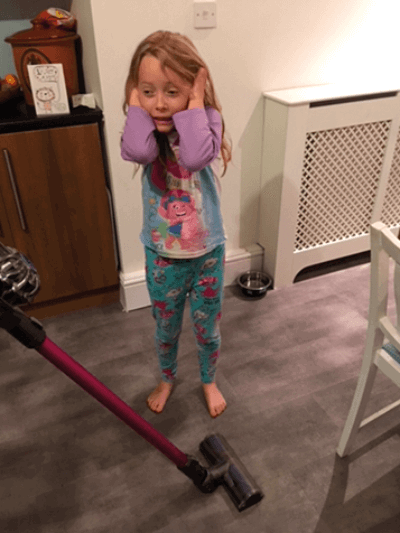Sound tolerance symptoms in young patients can be a challenge, Veronica Kennedy and Claire Benton share their clinical experience in navigating the issues that can arise in diagnosis and management.
In any noisy environment, it’s a common sight to see children holding their hands over their ears. For most children, this usually lasts until the noise has stopped. For a few children, the reaction to loud sounds can range from distress to panic attacks which can last for considerable time after cessation of the troublesome sound. The reported prevalence of hyperacusis in children varies between 3.2% and 17.1% [1].
This variability may relate to the variations in diagnosis. It may also relate to different populations of children, with a higher prevalence in preschool children and children with developmental difficulties, including autistic spectrum disorder [2].

Everyday sounds can be distressing.
Picture simulated from clinical experience of patients.
Sounds which are loud, unpredictable in onset or duration, and over which the child has no control tend to be particularly problematic. Common sounds which children find troublesome include that of vacuum cleaners, children screaming or playing, hand dryers, emergency sirens and alarms. While some definitions of hyperacusis refer to problems with everyday sounds, many of these sounds are really loud (see table). Little wonder children don’t like them!
“Anxiety in children can contribute to increased auditory gain and in turn to increased vigilance, exacerbating the hyperacusis.”
There may be different mechanisms underlying hyperacusis in children. In young children, maturation of the auditory system leads to improving intensity discrimination. In parallel, there is development of the sensory gating process which allows us to inhibit distracting or unwanted auditory information [3]. There is development of the frontal cortex leading to a decreased susceptibility to interference from environmental stimuli. Children also use non-classical auditory pathways in loudness perception. These pathways project to non-auditory areas of the brain, e.g. the limbic system and the amygdala, and are stimulated by somatosensory as well as auditory inputs [4]. This may account for the level of distress that some children experience and the ‘flight or fight’ or panic response.
Temporary auditory deprivation is a common experience in children with recurrent glue ear. The deprivation can lead to increased central auditory gain which, in turn, increases the perception of sound once the glue ear resolves. Some children may have a permanent auditory disorder. Those with William’s syndrome have some degree of hypersensitivity to sounds. Possible causes are postulated to include a hyperactive auditory efferent system and/or a lack of acoustic reflexes.
Some children with normal development, but particularly those with developmental and learning disorders, may have sensory over-responsivity, i.e. where a child has an exaggerated behavioural response to sensory stimulation including auditory stimulation. Children with autistic spectrum disorder often have abnormal sensory reactivity with a significant difficulty in auditory filtering. Where the environment is busy – for example, a supermarket or children’s party with its multiple sensory inputs (sights, sounds and smells) – this may lead to a ‘sensory overload’ where the child feels overwhelmed and may become distressed or go into a ‘meltdown’. Anxiety in children can contribute to increased auditory gain and in turn to increased vigilance, exacerbating the hyperacusis. Anxiety can present with the same behavioural correlates as anger, with the result that the child distressed by sounds who lashes out may end up being restrained rather than comforted.
So as clinicians, what do we do when we see a child in clinic who is sensitive to sounds? It is important to take a thorough history when seeing a child in clinic. Even young children can contribute to the history and can help explain the sounds or situations causing the most difficulty. The history should cover:
- Details of the troublesome noises
- Situations the child finds troublesome
- Reactions of the child and family
- Impact on the child and family
- Identifying useful coping strategies
- Use of safety behaviours e.g. avoidance of situations, use of ear defenders
Ability-appropriate audiological assessment should be done in a suitable paediatric setting. Children with hyperacusis may be more anxious about testing, so allowing plenty of time for the test and giving clear instructions and reassurance can help improve their confidence and therefore the reliability of the results. We don’t recommend uncomfortable loudness levels (ULLs). Asking a child, who has come to the clinic with distress on hearing loud sounds, to sit and listen to loud sounds seems somewhat unfair at best and cruel at worst, when the role of the audiologist should be to build a relationship of trust with that child.
Typical levels of some sounds that can be distressing
Sound
Vacuum cleaner
Typical levels
60-85dB
Sound
Hand dryer
Typical levels
70-85dB
Sound
Emergency vehicle siren
Typical levels
120dB
Sound
Children shouting
Typical levels
70-90dB
Sound
Baby crying
Typical levels
Up to 130dB
Sound
Fireworks
Typical levels
140dB
As with all good clinical management plans, the key is to individualise the management for the child and family in front of you. It will not only depend on the developmental age of the child and/or cognitive abilities, but also the lifestyle of the family. The strategies need to be meaningful to them and achievable. Involving the child in the development of the strategies gives them ownership and a great sense of achievement when successful [5]. The initial step should be to provide a clear explanation of hyperacusis to help the child understand why some things need to be loud. For young children, it can be helpful to involve them in activities relating to the sounds. Giving them some control of the sounds, such as ringing the school bell or starting the music class, can help. Having distraction techniques on hand can also be helpful as a coping strategy. For example, using ‘I spy’ lists for walks along busy roads or for supermarket trips. If these can include items that the child will find funny, so much the better, added motivation can be a reward for good spotting.
Finding ways that the child can relax is important and is key to the success of all management strategies. A good starting point might be to adapt the Child Friendly Tinnitus model to explore how anxiety and the sound sensitivity can reinforce one another is a good starting point [5]. For some families it will be all that is needed. Once you are confident the child and family understand how to begin to manage their anxiety, it is possible to encourage them to experiment with the sounds they dislike. This should be done in a gentle, step-by-step approach starting with a minimally distressing sound in order to build confidence. It is important to be able to recognise when a child’s anxiety will require specialist input.
“Involving the child in the development of the strategies gives them ownership and a great sense of achievement when successful.”
Sound therapy may be useful. It is tempting for those with sensitivity to sounds to try and control their environment and keep it as quiet as possible. However, the perception of sounds in a quiet environment can then seem louder in comparison. It is more effective to put on a quiet sound in the background to reduce the contrast in loudness of the sounds ie make the troublesome sound seem less loud. This helps the brain habituate to sounds and reduce the tendency to scan for or anticipate sounds which then cause distress. There is a variety of equipment, including apps, available which plays relaxing or environmental sounds. Some children may find that listening to quiet music on their earphones helps them. For a few children, the use of wearable sound generators may improve a child’s ability to tolerate the troublesome sounds, particularly when managing their anxiety is challenging. Conversely, the use of ear defenders or ear plugs can sensitise the auditory system further by causing auditory deprivation. If a child is coping by using ear defenders, it is important to reduce their use gradually while minimise their anxiety.
Whatever strategies are chosen to help a child manage hyperacusis, it’s important that the child is involved in this choice if possible and that all those supporting the child are consistent in following the strategies. This will help to minimise the distress associated with hyperacusis and reduce its impact.
Throughout both the assessment and management, you can’t go far wrong than to follow advice from Mary Poppins: “In every job that must be done, there is an element of fun. You find the fun, and – SNAP – the job’s a game.” Keep the process child focused and fun.
References
1. Nemholt Rosing S, Hvass Schmidt J, Wedderkopp N, Baguley DM. Prevalence of tinnitus and hyperacusis in children and adolescents: a systematic review. BMJ Open 2016;6:1-2.0
2. Myne S, Kennedy V. Hyperacusis in children: A clinical profile. Int J Pediatr Otorhinolaryngol 2018;107:80-5.
3. Davies PL, Chang W, Gavin WJ. Maturation of sensory gating performance in children with and without sensory processing disorders. Int J Psychophysiol 2009;72(2):187-97.
4. Moller AR, Rollins PR. The non-classical auditory pathways are involved in hearing in children but not in adults. Neuroscience Letters 2002;319(1):41-4.
5. Kennedy V, Benton C, Kentish R. Increased Sound Sensitivity in Children. In: Fagelson M, Baguley DM, (Eds.). Hyperacusis and Disorders of Sound Intolerance Clinical and Research Perspectives. Plural Publishing; 2018.







